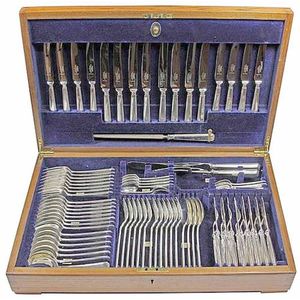Mappin & Webb Sterling Silver Cutlery Set
You must be a subscriber, and be logged in to view price and dealer details.
Subscribe Now to view actual auction price for this item
When you subscribe, you have the option of setting the currency in which to display prices to $Au, $US, $NZ or Stg.
- Sterling Silver - Sterling silver is a mixture of 92.5% pure silver and 7.5% of another metal, usually copper. Fine silver is 99.9% pure silver, and is relatively soft and the addition of the very small amount of copper gives the metal enough strength and hardness to be worked into jewellery, decorative and household objects.
- Cartouche - An ornamental panel in the form of of a shield, oval or rectangular scroll with curling edges. It may be carved into the back of a chair or the top of a sideboard, or present on a piece of silver or jewellery, and contain the initials of the original owner, heraldic symbols, or some other inscription, such as the details of a presentation.
In ceramics the term defines the central area of a vase or similar with a decorative border in one of the shapes above, into which a decorative scene or figures have been painted. - Oak - Native to Europe and England, oak has been used for joinery, furniture and building since the beginning of the medieval civilisation. It is a pale yellow in colour when freshly cut and darkens with age to a mid brown colour.
Oak as a furniture timber was superceded by walnut in the 17th century, and in the 18th century by mahogany,
Semi-fossilised bog oak is black in colour, and is found in peat bogs where the trees have fallen and been preserved from decay by the bog. It is used for jewellery and small carved trinkets.
Pollard oak is taken from an oak that has been regularly pollarded, that is the upper branches have been removed at the top of the trunk, result that new branches would appear, and over time the top would become ball-like. . When harvested and sawn, the timber displays a continuous surface of knotty circles. The timber was scarce and expensive and was used in more expensive pieces of furniture in the Regency and Victorian periods.
This item has been included into following indexes:
Visually similar items

A Mappin & Webb silver and ivory cutlery set, in original oak box, consisting of six dinner and six luncheon forks, six dinner and six luncheon knives, six dessert spoons, six teaspoons, two sauce ladles, four tablespoons, a pie spoon, large soup ladle, su

Silver plated canteen of cutlery by Mappin & Webb with additional cutlery. Consisting of eight soup spoons, eight dessert spoons, eight entree forks, eight entree knives, twelve main forks, eight main knives, four serving spoons, eight fish knives, eight f

English hallmarked sterling silver George V fish cutlery setting for twelve persons having xylonite handles, set in a oak navy blue velvet lined case. Sheffield, 1924, maker Martin Hall & Co Ltd. Condition good, minor age related wear, one fork handle slig

A boxed canteen of Viner & Hall silver plate cutlery for six, together with boxed fish service, retailed by Saunders of Sydney V&H missing tea spoon and part matched with Astor plate
